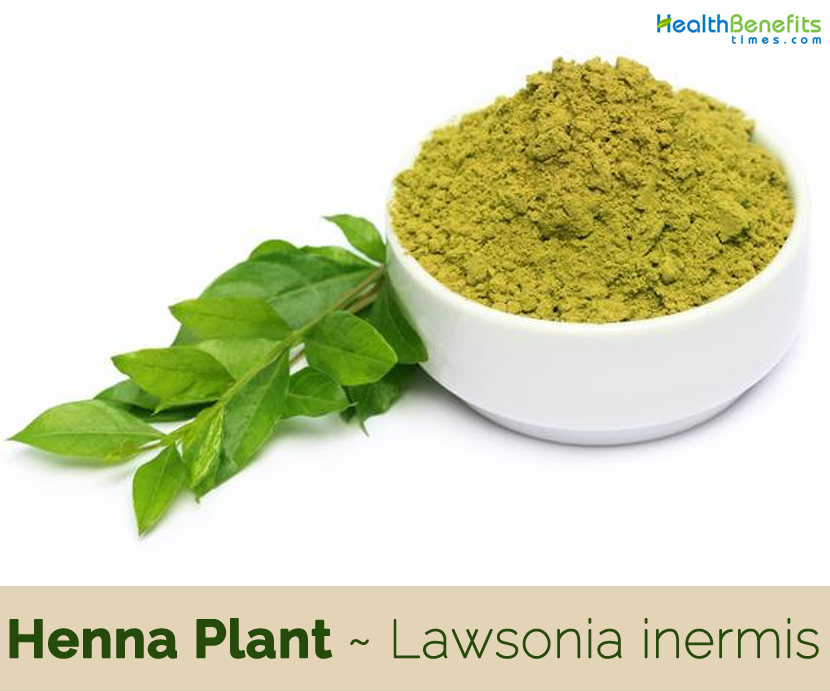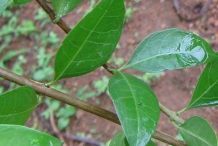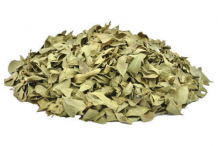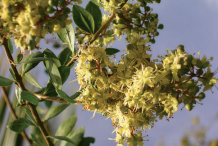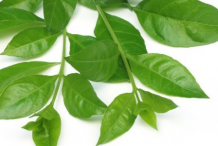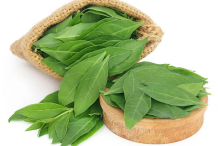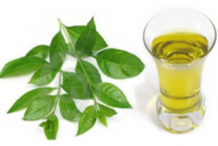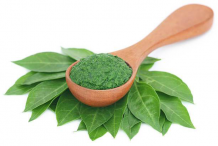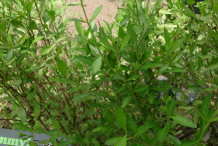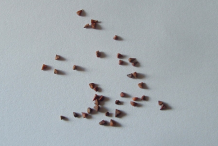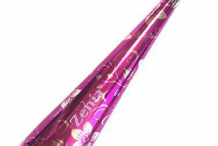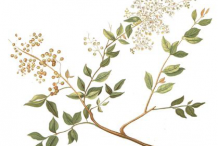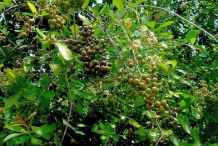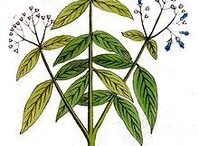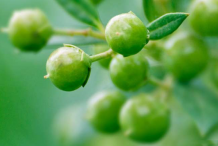| Henna Plant Quick Facts |
| Name: |
Henna Plant |
| Scientific Name: |
Lawsonia inermis |
| Origin |
Southwest Asia, North Africa, and India |
| Colors |
Brown |
| Shapes |
Small, globosely brownish capsules, 4–8 mm (0.16–0.31 in) in diameter, with 32–49 seeds per fruit |
| Taste |
Bitter, acrid |
| Health benefits |
Regulated Blood Pressure, Dysentery, Anti-aging Properties, Improved Nail Quality, Baldness, Arthritis, Headache Reliever, Wound Healing, Cure Fever, Anti-inflammatory Capacity, Reduced Sleep Issues, Hair Color, Detoxification |
Henna (hina) scientifically known as Lawsonia inermis is actually a flowering plant belonging to the Lythraceae (Loosestrife family) (a family of flowering plants that includes 620 species). It is the only plant species in the genus Lawsonia. The plant is native to southwest Asia, North Africa, and India, but has also become naturalized in warmer parts of South and North America, Australia and the West Indies. Some of the common names of the plant are Hina, Henna, Jamaica mignonette, Mignonette tree, Egyptian-privet, alcana, camphire, Mignonette bush, Smooth Lawsonia, Cypress Shrub, Henna Plant, Mindie, inai, hinai and Pacar kuku. The word ‘henna’ is understood by people around the world in many different ways. A majority of people probably associate it with the dark-red/brown dye.
The English name “henna” comes from the Arabic (ḥinnā). The name henna also refers to the dye prepared from the henna plant and the art of temporary tattooing based on those dyes. It has been used to create beautiful, temporary body art in cultures around the world for thousands of years. Henna has been used for centuries to dye skin, hair, and fingernails, as well as fabrics including silk, wool, and leather. It is cultivated in Africa and Asia for both medicinal and industrial (dyeing) purposes. In India, Pakistan and other parts of Southeast Asia, henna is often called mehndi (also spelt mehendi).
Plant Description
Henna is a heavily-scented, slender, much-branched, evergreen, glabrous shrub or small tree that grows about 1.8 to 7.6 m (6 to 25 ft.) tall. The plant is found growing in dry, coastal secondary scrub wasteland, temporarily flooded river beds, riverine thickets, and hillsides and in rock crevices. It is also found growing mainly along waterways and in semi-arid regions and is modified to a wide range of environmental conditions. It can endure low air humidity and drought conditions. The plant prefers a fertile, well-drained or dry soil in a sunny position. The plant is tolerant of poor, stony and sandy soils, but is also well adapted to heavy, fertile clay soils. Established plants are very drought tolerant. The plant has greyish-brown bark. Young branches are quadrangular and green but these branches turn red with age. The stems and older branches can be spiny. Leaves are opposite, entire, sub-sessile, elliptic to broadly lanceolate, 8-44 mm long, 2-20 mm broad, glabrous, acuminate; while veins on the upper surface are depressed and have a tea like aroma.
Flower & Fruits
Flowers are small, white, numerous in large pyramidal terminals, fragrant, 1 cm across with 4 petals crumpled in the bud. The calyx has 2 mm tube and 3 mm spread lobes. Petals are orbicular to ovate, white or red. It has 8 stamens, inserted in pairs on the rim of the calyx tube. Ovary is 4 celled and the style up to 5 mm long, erect. Flowering normally takes place from April and May. Flowers are followed by small, globosely brownish capsules, 4–8 mm (0.16–0.31 in) in diameter, with 32–49 seeds per fruit, and open irregularly into four splits. Seeds are 3 mm across, brown pitted, numerous small and pyramidal in shape and possess thick seed coat. The seeds of henna plant require high temperatures for germination, growth and maximal development.
Health benefits of Henna Plant
Despite that henna has mainly be used as dye plant, it is also known for its medicinal properties. Leaves are used in traditional folk medicine in India, many Muslim countries and North Africa. Herb is used in Ayurvedic and Unani medicine as a gargle for bad throat and extracts or decoction have been used as herbal remedies for diarrhea, amoebic dysentery, ulcers, tapeworms, and fever. Let’s take a more in-depth look at the many impressive health benefits of this adaptable beautifying plant.
1. Anti-aging Properties
Though the antioxidant capacity of henna has not been widely researched, the oil has been proven to be an astringent, which has led many people to use its juice and oil on the skin to reduce the signs of aging and wrinkles, as well as the unattractive appearance of scars and other blemishes. This is complemented by the antiviral and antibacterial effects that can protect the body’s largest organ, skin! (1)
2. Improved Nail Quality
People often forget about maintaining healthy nails, but the cuticles and space under the nails are prime sites for infection and bacterial presence. Therefore, treating your nails with henna is considered a wise choice. Drinking the water in which leaves have been soaked helps prevent nails from cracking and reduce inflammation. Applying a poultice directly to the nail beds can clear up irritation, pain, and infection in the nail beds. (2)
3. Wound Healing
Henna is considered quite beneficial for protecting the skin against infections and eliminating inflammation. It has been applied to burns, wounds, and scrapes for generations, not only because it can add a protective layer against foreign pathogens and substances, but also because it has natural cooling abilities that accurately suck the heat from the skin. This makes it very useful for sunburns, in a similar capacity as aloe vera gel.(3)
4. Cure Fever
According to the ayurvedic traditions henna also helps to bring down fevers. When people are suffering from very high fevers as a secondary symptom of another condition that rise in temperature throughout the body can be dangerous for organ function and metabolic processes. Bringing the overall temperature of the body down is vital, and henna can achieve this by either inducing sweating and effectively breaking the fever, or simply cooling the body and providing some relief. (4)
5. Reduced Sleep Issues
Henna oil has been directly related to alleviating certain sleep disorders, so if you are suffering from insomnia or chronic restlessness, adding a bit of this oil to your herbal routine can get you back into a regular, restful schedule of sleep by calming the body and mind, easing it into a relaxed state before sleep. (5)
6. Hair Color
Although most people associate henna’s effect on the hair to dying its color, it actually plays a number of roles in that part of our body too. Henna has been proven to increase the strength of the hair and, hence, represents a safe dye that doesn’t permanently affect the health of our follicles. (6)
7. Detoxification
Consuming the consequent liquid obtained by soaking the bark or leaves of the henna plant in water has been associated to improved spleen and liver health. The liver works as a crucial level of protection for the body and helps to remove the toxins that accumulate in the body. By optimizing its function and ensuring its health, you can avoid a wide range of other health conditions. (7)
8. Headache Reliever
Juice of the henna plant is not always praised as being particularly beneficial, but in fact, the juice of the plant can be directly applied to the skin for fast relief from headaches. The anti-inflammatory effects of the compounds found in henna help it reduce that tension and promote healthy blood flow in the capillaries, which is a common cause of headaches and migraines. (8)
9. Anti-inflammatory Capacity
Henna oil can be used topically for arthritic and rheumatic pains. As we age, our joints become more painful as cartilage and muscles worsen. This can result in painful inflammation in many different parts of the body. By applying hina oil to the inflamed or affected areas, you can guarantee a healthier and broader range of motion to maintain an active and happy life. (9)
10. Regulated Blood Pressure
If you consume henna water or seeds, you can enjoy a hypotensive effect that relieves stress on the cardiovascular system and efficiently lowers blood pressure. This can help prevent the plaque and platelet build-up in the heart and arteries, avoiding heart attacks and strokes. (10)
11. Arthritis
Henna oil is considered beneficial for rheumatic and arthritic pains. Ground leaves are applied to sore flints to ease rheumatism. Juice of the medicinal plant can be applied to the skin for headaches, and the henna oil is applied to hair to prevent it from graying.
12. Dysentery
Bark of the plant is very effective in the treatment of dysentery. Seeds are powdered, mixed with ghee and rolled into small balls and then taken with water.
13. Baldness
Using mustard oil boiled with Henna leaves encourages healthy hair growth. 250 grams of mustard oil is boiled in a pan. Some 50 to 60 grams of Henna leaves are added gradually to the oil and heated. The oil is then filtered through a cloth and stored in a bottle. Regular massage with this oil produces abundant hair.
https://www.youtube.com/watch?v=jvQOylN7mz4
Traditional uses and benefits of Henna
- Bark is used as an emenagogue in French Guiana.
- Javans make a poultice from the leaf and apply it to cracks between the toes.
- Water infusion of the leaves mixed with tobacco and salt is used for a mouthwash in Surinam.
- Leaf cooked in water and used for washing wounds.
- It is used to treat wounds, dartre, and possibly leprosy in French Guiana.
- It has been used both internally and locally in jaundice, leprosy, smallpox, and affections of the skin.
- Fruit is supposed to have emenagogue properties.
- Egyptians are said to have prepared both oil and an ointment from the flowers for making the limbs supple.
- It is beneficial in keeping the Scalp free from Infection and Dandruff.
- It increases strength and shine to the Hair thus, makes it Frizz free.
- It boosts Hair growth and suppresses hair fall, sweating and hair thinning.
- It is a natural source of nourishment and avoids baldness.
- Its flowers counter Headaches which are a result of Sunstroke.
- It fights Epilepsy.
- It cures dental ailments like Scurvy i.e. bleeding of gums and oral ulcers.
- Gargles done using Henna leaves are advantageous in curing throat infections.
- Henna is a good herbal remedy for the treatment of nervous disorders namely leprosy and tetanus i.e. lockjaw.
- It is utilized for curing bronchitis and cough, which may cause breathing discomfort.
- It keeps tuberculosis at bay.
- It alleviates the troubles associated to blood circulation.
- It is beneficial in combating Skin problems like Eczema, Burns, Allergies, Bruises, Psoriasis, Prickly Heat, Abscess and Skin Inflammation.
- It helps in treatment of obesity i.e. over weight.
- It curbs digestive complaints like Acidity.
- Henna is good herbal remedy for Liver troubles namely, Hepatomegaly i.e. Liver Enlargement and Jaundice.
- It calms the abdominal pain post Delivery.
- It stops dysentery.
- It alleviates muscular pain and joint pain in rheumatism.
- It counters gonorrhea.
- Henna is powerful in countering Menopausal troubles like Heavy Bleeding and Irregular Menses.
- It counteracts Leucorrhoea i.e. vaginal discharge.
- Henna paste is helpful in easing foot inflammations; those are an outcome of foot soles.
- Decoction made from the bark has been used to treat some liver diseases.
- Externally the leaves have been used to treat high fever, headache, joint pain and dermatitis.
- Leprosy in early stages can be treated by Henna.
- They are used as a gargle to treat sore throats.
- Leaves are, used externally in the treatment of various skin diseases (including leprosy), wounds, ulcers and herpes.
- An infusion of the leaves is mixed with tobacco and salt and used as a mouthwash.
- Dyeing the hair with henna effectively kills lice.
- Stem bark is chewed and then kept between the teeth for about 25 minutes in order to treat toothache.
Ayurvedic Health benefits of Henna
- Grey hair: Mix powdered Henna leaves with Coconut oil. Use it as hair oil. OR : Make a paste of Henna leaves by adding some water in it. Apply the paste on the hairs. Leave it for 6 hrs. Wash.
- Insomnia: Grind Henna flowers to make a paste. Take half a teaspoon of this paste once a day.
- Jaundice: Take dried plant of Henna. Make a decoction of it. Drink 20 ml of it once a day. This is the traditional remedy to treat Jaundice
- Fungal nails: Grind some leaves of Henna to make paste. Bandage the affected area using this paste.
- Inflammation: Apply oil of Henna seeds over inflamed areas. It helps to reduce the burning sensation.
- Skin: Prepare a leave decoction of Henna. It can be taken internally or used externally, for skin problems.
- Burns: Apply leave paste of Henna over Burns. Its cooling effect helps in healing the damaged Skin fast.
- Boils: Grind leaves of Henna to make paste. Apply it over Boils.
- Spermatorrhea: Crush some fresh Henna Leaves. Squeeze them to extract the juice. Have a teaspoon of juice with milk once or twice a day until the problem will disappear
- Leucorrhoea: Extract juice from fresh Henna Leaves. Store it in a glass bottle. Take a teaspoon of juice with a glass of milk. It helps to cure Leucorrhea.
- Prickly Heat: Take a handful of Henna leaves. Make a paste by crushing Henna leaves and water. Apply the paste on the affected Skin. Leave it for 10 to 15 minutes. Wash with cold water.
- Migraine: Dip flowers of Henna in vinegar. Steep them for 10 minutes. Rub them against the forehead for quick Migraine pain relief.
- Hepatomegaly: Prepare a decoction, made of powdered Henna bark and one cup of hot water. Drink it, once a day.
- Hepatosplenomegaly: Prepare a decoction, made of powdered Henna bark and one cup of hot water. Drink it, once a day
- Hair problems: Boil Henna leaves in Mustard Oil. Let it cool. Strain it and gently massage with this oil over your scalp. It promotes Hair growth.
- Eczema: Apply the Oil of Heena seeds on the affected area. Repeat the process two times a day. It will provide relief from Eczema.
- Scabies: Gently massage with the Henna seed oil over the affected area. Repeat the process two times a day.
- Candidiasis: Gently massage with the Henna seed oil over the affected area. Repeat the process two times a day.
- Burning feet: Soak fresh leaves of Henna in Vinegar for 5 minutes. Bandage the soaked leaves onto the soles of the feet. It will provide relief from Burning Feet.
- Headache: Grind Henna flowers and Vinegar to make a fine paste. Apply it on the forehead. It will provide relief from Headache caused by heat of the sun.
- Liver Diseases: Prepare a decoction, made of Henna leaves and one cup of water. Strain and drink 30 ml of this decoction, once a day.
- Dysentery: Mix dried Henna powder with Clarified Butter. Roll them into small balls. Consume one ball with one glass of water, once a day
- Antiseptic: Mix two tablespoon of dried Henna herb powder with half cup of Apple Cider Vinegar. Slightly warm it. This mixture serves as an Antiseptic.
- Antibacterial: Mix two tablespoon of dried Henna herb powder with half cup of Apple Cider Vinegar. Slightly warm it. This mixture serves as an Antibacterial.
- Antifungal: Mix two tablespoon of dried Henna herb powder with half cup of Apple Cider Vinegar. Slightly warm it. This mixture serves as an Antifungal.
- Baldness: Soak 8 to 10 Indian Gooseberry in one glass of water at night. In the morning, strain the water. Add 2 tablespoons Henna powder in strained water. Apply on your hair for an hour once a week. It gives black color to your hair.
- Dandruff: Mix 3 to 4 tablespoons of Henna leaves powder and water to form thick paste. Add 1 to 2 tablespoons of Beetroot powder in it. Mix well. Apply it on the scalp. Leave it for 2 to 3 hours. Wash off and Shampoo. Do this once a week.
- Grey hairs: Boil 20 g Henna leaves in 50 ml Mustard oil. Use it for hair massage.
- Post Childbirth problems: Take 30 g roots of Elephantopus Scaber, 20 g Heena leaves and 25 g Guava leaves. Boil them together in water to make decoction. Take 20 ml of it once a day. It helps in restoring the Womb after Pregnancy.
- Frizzy hairs: Take 4 Tablespoon Henna Powder, 2 teaspoon Lemon Juice, 1 tablespoon Cucumber Juice, and 1 tablespoon Orange Juice. Put all ingredients in a bowl. Mix. Apply on hair twice a month.
- Baldness: Heat 25 gram Henna leaves in 100 gram of White Mustard oil until leaves turn to black. Cool and strain. Apply lukewarm on scalp twice a week. It is a very effective remedy for hair fall.
- Baldness: Take 50 gram Henna leaves and boil in 20 ml Brown Mustard oil until they turns black. Strain. Massage your scalp with lukewarm oil thrice a week.
- Baldness: Boil One cup dried Henna Leaves in 500 ml Coconut Oil for 15-20 minutes. Strain and store in a cool place. Massage this oil on the scalp thrice a week.
- Dandruff: Take mixture of Black Cumin Seed oil, Olive oil and Henna leaves powder in 1:3:3 ratios. Heat them. Let it cool. Apply on your Scalp and Hair.
- Grey hair: Here is a formula which helps to stop graying of hair. It is not miracle formula. It needs time and patience. It may be possible that one or two application do not give desirable results. Later on, you will see very noticeable changes in your hair.
- Step 1: Boil 4 to 5 big slices of Bottle Gourd and one medium sized Beetroot in 1 to 2 cup of water.
- Step 2: Mash them well in water. Strain the water.
- Step 3: Put this water in an iron pot and add 3 to 4 tablespoons of Henna.
- Step 4: Roast 2 tablespoons of Indian Gooseberry powder until you see the gust of smoke coming up.
- Step 5: Put the roasted powder in the mixture. Blend them well. Apply the mixture on the scalp and hair properly. Leave it for minimum 3 to 4 hours.
- Step 6: Wash with plain water. Do not shampoo your hair for 3 days.
- Frizzy hair: Soak a handful of dried Indian Gooseberry and 2 tablespoons of Fenugreek seeds in water overnight. Next day, grind them. Add equal quantity of Henna and a tablespoon of Brown Mustard oil. Mix them. Apply it over scalp and hair. Wash with normal water after 3 to 4 hours.
- Prickly heat: Grind the fresh leaves of Henna and Azadirachta Indica to form a thick paste. Apply the paste on the affected Skin. Leave it to dry for 15 to 20 minutes. Rinse off with cold water. Repeat it 2 to 3 times a week to cure Prickly Heat.
- Hair fall: Boil ground Beetroot leaves and mixed with Henna and prepare a paste. Apply this paste on your hair scalp for 20 minutes. Wash your hair with lukewarm water.
- Baldness: Prepare a paste by blending Indian Gooseberry, Henna and Liquorice together. Apply it on scalp two times in a week.
- Mental Disorders: Give 3 gm. seeds of Henna with honey to the patient. OR, give the decoction of its flowers to the patient.
- Jaundice: Soak 5 gm. henna leaves in an earthen pot over night. Next day morning strain the solution and give this to the patient. Within 1 week, it cures Jaundice.
- Dermatoses: Give 1/2 teaspoon of juice of its leaves and flowers. Give it twice a day for 7 days. It is beneficial in curing dermatoses.
- Pain due to Fever: Boil 10 gm. leaves in 200 gm. water. Then prepare its hot infusion and give this-to the patient. It helps cure the internal burning sensation due to fever, reduces headache and gives strength to the heart and also promotes sleep.
- Chicken pox: Grind its leaves and apply the paste on the lower side of the foot. It reduces the impact of Chicken pox in eyes.
- Calculus: Boil 10 gm. henna bark in an earthen pot. Next day morning, strain the solution and give it to the patient. It releases the stone in kidney. OR Soak henna leaves and wood in a glass of water for overnight. Next morning, decant the solution. Give 2 gm. Yavakshar to the patient with this. Repeat this treatment for a few days. It dissolves the stones which then get released through urine.
- Dysuria: Prepare 50 gm. cold infusion of Henna and add 1 gm. of kalmishora in it. Give this to the patient twice a day.
- Bleeding Diarrhea: Grind its seeds and mix the paste with ghee and prepare berry shaped tablets. Give these tablets to the patient twice day with water.
- Knee pain: Grind equal quantities of its leaves along with the leaves of castor oil-plant. Slightly warm the paste and apply on the knees. It gives relief from pain in few uses.
- Redness of eyes: Take 10 gm. henna and cumin seeds. Grind them coarse and soak them in rose water for overnight. Next day morning, strain the solution and store it in a glass bottle. Mix 1 gm. roasted and powdered alum in it. Put drops of this solution in eyes when required. It cures redness of eyes. OR Prepare poultice of its leaves and then warm it in milk and tie on the eyes. It cures paining and burning sensation in eyes.
Modern Applications of Henna Plant
- Temporary tattoos
- Henna Nourisher or hair conditioner as shampoo
- Skin care products
- Natural hair dyes
- Body decoration
- Henna Hair tonic
- Henna Essential Oils
Different Hair packs using henna
If you’re wondering how to include this magic ingredient in your beauty regimen, please, let us help. These handy hair masks and hair packs can be made right in your own kitchen, and will be amazingly beneficial for your hair.
Henna, egg and curd mask
Mix 2 tbsp of henna powder and 1 tbsp of shikakai powder with some water to make a paste. Let this soak overnight. In the morning, add one egg and 1 tbsp curd to the mix. Apply this directly onto the roots and lengths of your hair, and leave it on for 45 minutes. Wash it off with cold water and a mild shampoo. Repeat this once a week for a gorgeous, shiny mane.
Henna and banana hair pack
Mix 2 tbsp of henna powder with some water to make a thick paste, and soak it overnight. Mash a ripe banana into the paste in the morning and set it aside. Wash your hair regularly with a shampoo, and use this pack instead of a conditioner. Just apply it on and let it works its magic for five minutes, before washing it off with cold water. Repeat once a week.
Henna and multani mitti hair pack
Mix 2 tbsp of henna and 2 tbsp of multani mitti with some water to make a consistent paste. Apply this on your hair before you turn in for the night, wrapping your hair in an old towel so as to not soil your sheets. Wash the pack off with a mild shampoo in the morning. Repeat once a week to cleanse your scalp and curb hair loss.
Henna and amla hair pack
Mix a cup amla powder and 3 tbsp henna powder with 2 tbsp fenugreek powder and some water to make a paste. Add an egg white and the juice of a lemon to the mix, and let it soak for an hour. Apply this directly on to the roots and lengths of your hair, and leave it on for 45 minutes. Wash it off with a mild shampoo, and repeat it once a week to boost hair growth.
Henna and coffee hair color pack
Boil 1 tbsp of instant coffee powder in a pot for a couple of minutes, and take it off the flame. Take 5 tbsp henna in a bowl, and pour the coffee in while it’s still warm. Ensure that there are no lumps. Apply the henna and coffee mixture on to sections of your hair, making sure to cover the roots. Leave the pack on for 3-4 hours, and wash it off with a mild shampoo and cold water before conditioning your hair. You can repeat this process once a month for gorgeous brunette locks.
Other facts
- Leaf paste is used to dye hands.
- Dye is used for dyeing cloth and hair, for staining nails, palms and soles, and in medicine.
- Powdered leaves have been in use from the most ancient times in Eastern countries for dyeing the hair and the nails a reddish-yellow.
- It is traditionally planted as a windbreak in vineyards.
- Crushed leaves are used to prepare a very fast reddish or yellowish dye.
- An essential oil obtained from the flowers is used in perfumery.
- Fibers of the branches and the stem bark are used to make baskets.
- Small twigs are used as toothbrushes.
- Seed oil is occasionally used locally for purposes such as anointing the body.
- Wood is fine-grained and hard. It is used for making small objects such as tent pegs and tool handles.
- Wood is used for fuel.
Precautions
- Henna should not be used during pregnancy and lactation.
- This substance has been banned for use on skin in many western countries, but it can be difficult to control if it is present in hair dyes or tattoo color.
- Those experiencing an allergic reaction to black dye like itching or blistering, should consult a doctor and report that they might have applied p-phenylenediamine on the skin.
References:
https://www.itis.gov/servlet/SingleRpt/SingleRpt?search_topic=TSN&search_value=503345#null
https://davesgarden.com/guides/pf/go/62228/
http://www.hear.org/pier/species/lawsonia_inermis.htm
https://www.cabi.org/isc/datasheet/29956
https://www.botanical.com/botanical/mgmh/h/henna-24.html
https://plants.usda.gov/core/profile?symbol=LAIN5
http://www.theplantlist.org/tpl1.1/record/kew-2353863
https://scialert.net/fulltextmobile/?doi=ijp.2012.483.489
https://en.wikipedia.org/wiki/Henna
https://en.wikipedia.org/wiki/Lawsonia_inermis
https://uses.plantnet-project.org/en/Lawsonia_inermis_(PROTA)
https://www.researchgate.net/publication/299545214_Lawsonia_Inermis_Linn_A_Plant_with_Cosmetic_and_Medical_Benefits
Comments
comments


